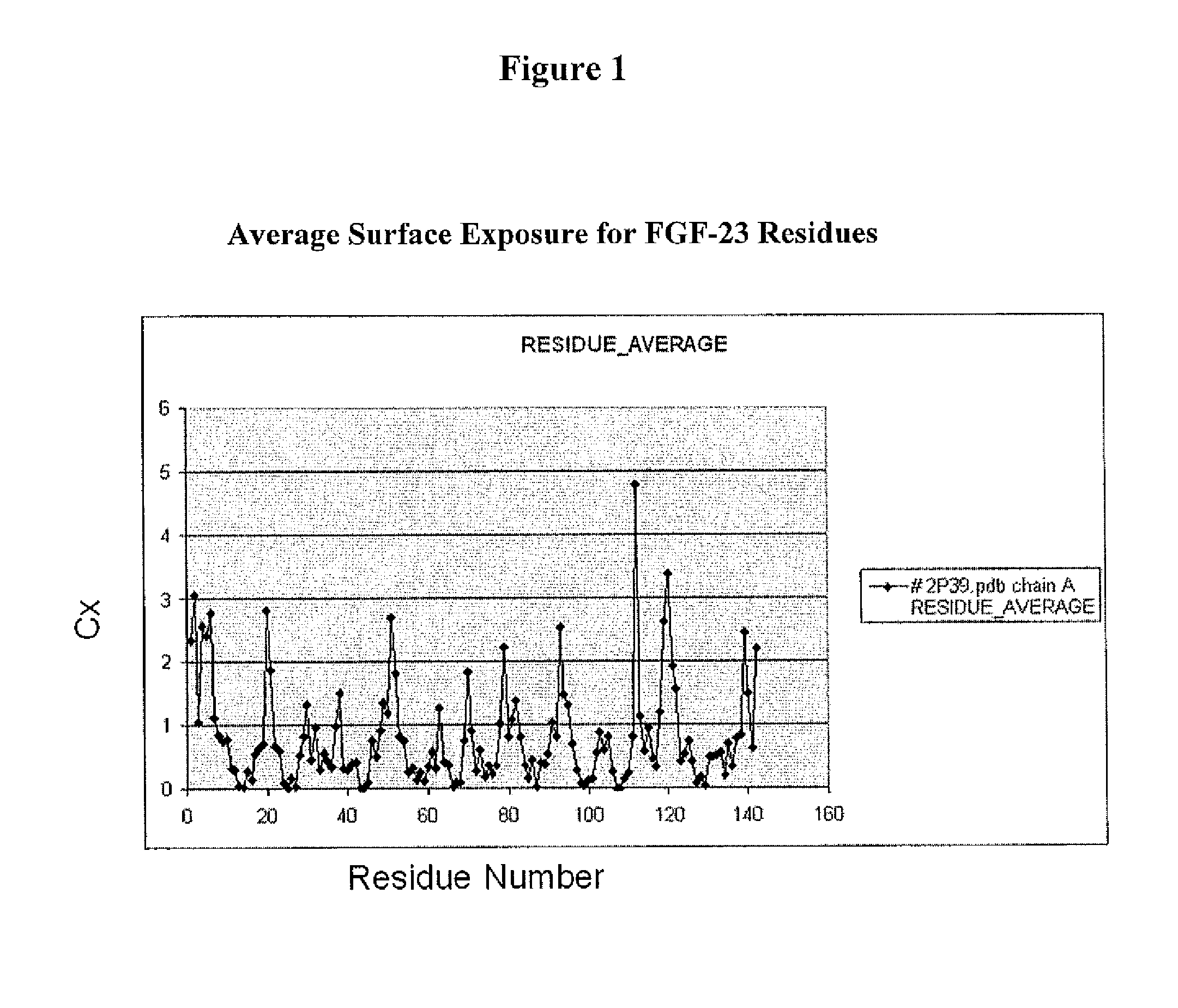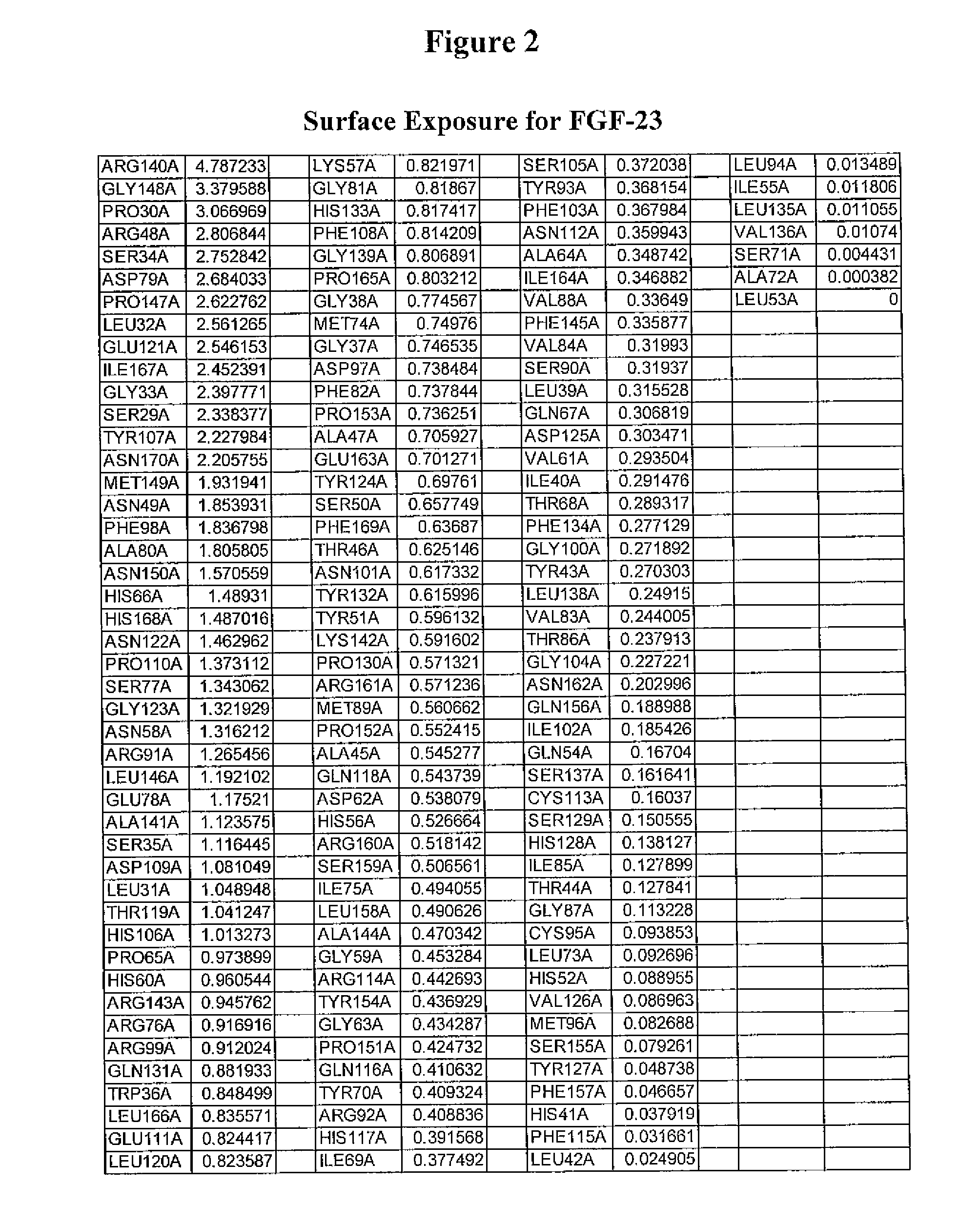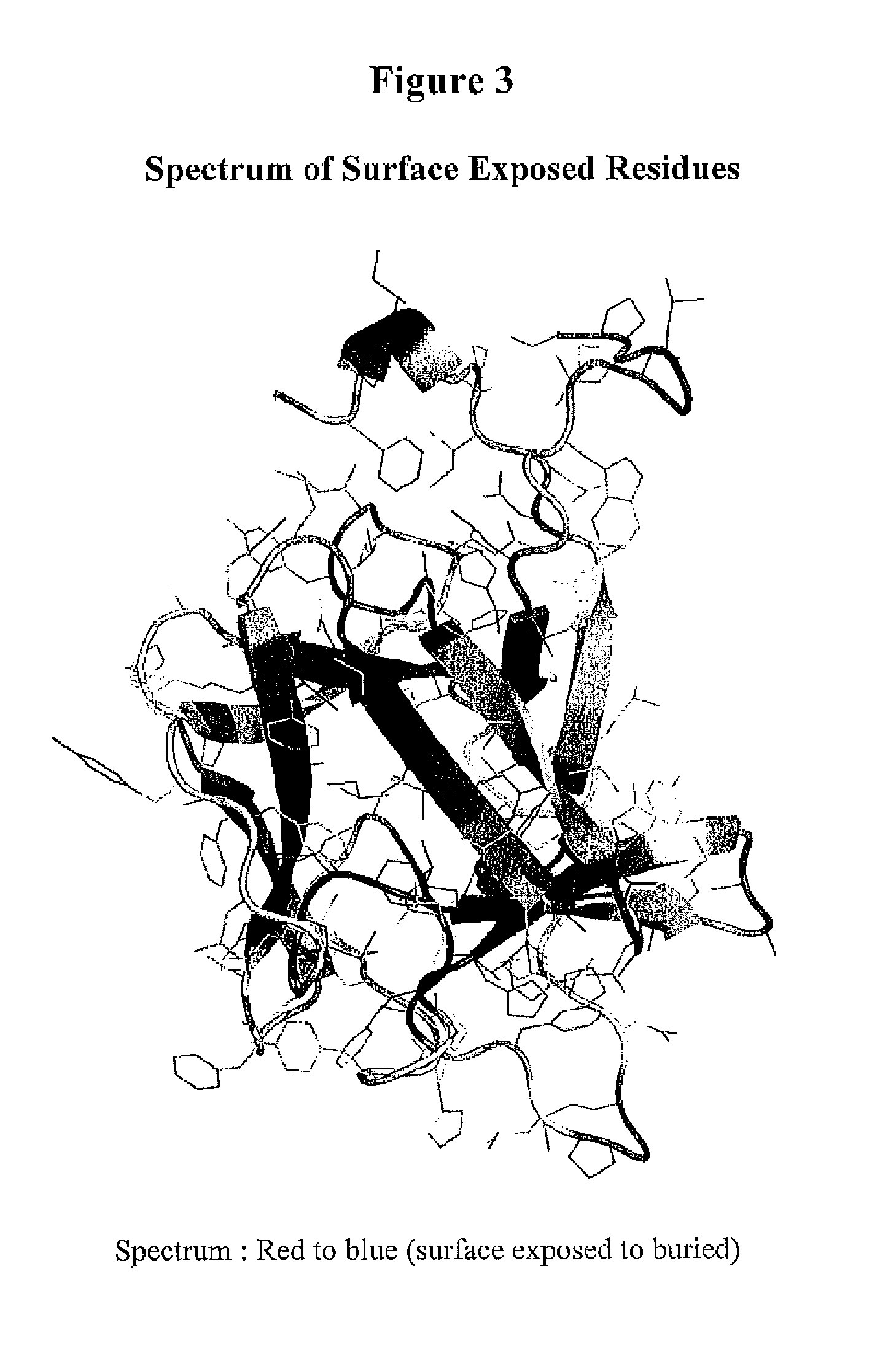Modified FGF-23 Polypeptides and Their Uses
a technology of lysine residues and polypeptides, which is applied in the field of fgf23 polypeptides, can solve the problems of increasing the risk of reducing the inability to selectively install peg derivatives among the often numerous lysine residues present on the surface of proteins, and the inability to reduce the risk of a reduction or even total loss of bioactivity of the parent molecule, etc., to improve the therapeutic hal
- Summary
- Abstract
- Description
- Claims
- Application Information
AI Technical Summary
Benefits of technology
Problems solved by technology
Method used
Image
Examples
example 1
[0671]This example describes one of the many potential sets of criteria for the selection of sites of incorporation of non-naturally encoded amino acids into FGF-21.
[0672]FIG. 1 shows the sequence homology between FGF-21 (Protein accession number BC018404) and FGF-19 (Protein accession number BAA75500) as determined using Vector NTI (Invitrogen; Carlsbad, Calif.). The amino acids marked with an asterisk are similar between the two molecules. The amino acids that are underlined are identical between the two polypeptides. Seven different FGF-21 polypeptides were generated by substituting a naturally encoded amino acid with a non-naturally encoded amino acid. Each polypeptide had one of the amino acids marked with a rectangle in FIG. 1 substituted with para-acetylphenylalanine. The polypeptides generated lacked the leader sequence shown in FIGS. 1 and 3 and were His tagged at the N terminus with 6 histidine residues. SEQ ID NO.: 1 is a 181 amino acid sequence of human FGF-21 (P form) w...
example 2
[0681]This example details cloning and expression of a FGF-23 polypeptide including a non-naturally encoded amino acid in E. coli. This example also describes one method to assess the biological activity of modified FGF-23 polypeptides.
[0682]Methods for cloning FGF-23 are known to those of ordinary skill in the art. Polypeptide and polynucleotide sequences for FGF-23 and cloning of FGF-23 into host cells are detailed in U.S. Pat. No. 6,716,626; U.S. Patent Publication Nos. 2005 / 0176631, 2005 / 0037457, 2004 / 0185494, 2004 / 0259780, 2002 / 0164713, and 2001 / 0012628; WO 01 / 36640; WO 03 / 011213; WO 03 / 059270; WO 04 / 110472; WO 05 / 061712; WO 05 / 072769; WO 05 / 091944; WO 05 / 113606; WO 06 / 028595; WO 06 / 028714; WO 06 / 050247; WO 06 / 065582; WO 06 / 078463, which are incorporated by reference in their entirety herein.
[0683]An introduced translation system that comprises an orthogonal tRNA (O-tRNA) and an orthogonal aminoacyl tRNA synthetase (O-RS) is used to express FGF-23 containing a non-naturally enc...
example 3
[0695]This example details introduction of a carbonyl-containing amino acid and subsequent reaction with an aminooxy-containing PEG.
[0696]This Example demonstrates a method for the generation of a FGF-23 polypeptide that incorporates a ketone-containing non-naturally encoded amino acid that is subsequently reacted with an aminooxy-containing PEG of approximately 5,000 MW. Each of the residues before position 1 (i.e. at the N-terminus), 1, 2, 3, 4, 5, 6, 7, 8, 9, 10, 11, 12, 13, 14, 15, 16, 17, 18, 19, 20, 21, 22, 23, 24, 25, 26, 27, 28, 29, 30, 31, 32, 33, 34, 35, 36, 37, 38, 39, 40, 41, 42, 43, 44, 45, 46, 47, 48, 49, 50, 51, 52, 53, 54, 55, 56, 57, 58, 59, 60, 61, 62, 63, 64, 65, 66, 67, 68, 69, 70, 71, 72, 73, 74, 75, 76, 77, 78, 79, 80, 81, 82, 83, 84, 85, 86, 87, 88, 89, 90, 91, 92, 93, 94, 95, 96, 97, 98, 99, 100, 101, 102, 103, 104, 105, 106, 107, 108, 109, 110, 111, 112, 113, 114, 115, 116, 117, 118, 119, 120, 121, 122, 123, 124, 125, 126, 127, 128, 129, 130, 131, 132, 133, ...
PUM
| Property | Measurement | Unit |
|---|---|---|
| molecular weight | aaaaa | aaaaa |
| molecular weight | aaaaa | aaaaa |
| molecular weight | aaaaa | aaaaa |
Abstract
Description
Claims
Application Information
 Login to View More
Login to View More - R&D
- Intellectual Property
- Life Sciences
- Materials
- Tech Scout
- Unparalleled Data Quality
- Higher Quality Content
- 60% Fewer Hallucinations
Browse by: Latest US Patents, China's latest patents, Technical Efficacy Thesaurus, Application Domain, Technology Topic, Popular Technical Reports.
© 2025 PatSnap. All rights reserved.Legal|Privacy policy|Modern Slavery Act Transparency Statement|Sitemap|About US| Contact US: help@patsnap.com



